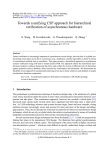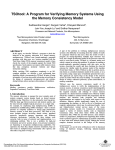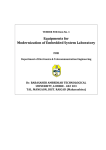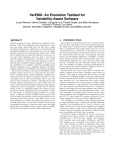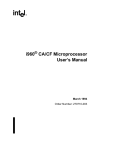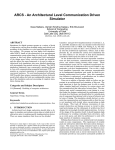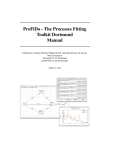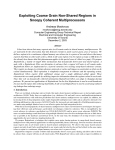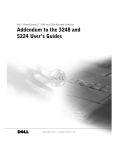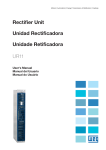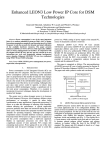Download Serializing Instructions in System-Intensive Workloads
Transcript
Appears in 14th International Symposium on High-Performance Computer Architecture (HPCA ’08)
Serializing Instructions in System-Intensive Workloads:
Amdahl’s Law Strikes Again
Philip M. Wells and Gurindar S. Sohi
Computer Sciences Department
University of Wisconsin-Madison
{pwells,sohi}@cs.wisc.edu
Abstract
such as those that write control registers and cannot be executed out-of-order (OoO), as an additional, major component of poor OS performance.
OoO processors achieve parallel execution of a sequential program, albeit at the level of instructions and memory
operations. SIs introduce a short sequential section into this
parallel execution. As Amdahl’s Law explains, frequent serialization can greatly limit performance regardless of the
amount of parallelism available the rest of the time.
We show that the OS performance impact of SIs rivals
the impact of misses to main memory, accounting for 25–
60% of the higher system CPI. Several additive trends are
increasing the cost and frequency of SIs, including processors which can maintain thousands of instructions in flight,
the use of speculative or redundant multithreading, and trapand-emulate software virtual machines.
Despite being a major performance factor, SIs have received little public attention from academic or industry researchers. This lack of attention is likely because SIs are
viewed as specific to a particular processor implementation.
In reality, SIs share many common characteristics across of
range of ISAs and processors, and thus, we believe deserve
a close examination. We aim to explore the origin of SIs
in more detail, investigate their impact on performance, and
propose solutions to mitigate this impact.
Serializing instructions (SIs), such as writes to control
registers, have many complex dependencies, and are difficult to execute out-of-order (OoO). To avoid unnecessary
complexity, processors often serialize the pipeline to maintain sequential semantics for these instructions.
We observe frequent SIs across several system-intensive
workloads and three ISAs, SPARC V9, X86-64, and PowerPC. As explained by Amdahl’s Law, these SIs, which create serial regions within the instruction-level parallel execution of a single thread, can have a significant impact
on performance. For the SPARC ISA (after removing TLB
and register window effects), we show that operating system
(OS) code incurs a 8–45% performance drop from SIs.
We observe that the values produced by most control register writes are quickly consumed, but the writes are often
effectively useless (EU), i.e., they do not actually change
the execution of the consuming instructions. We propose
EU prediction, which allows younger instructions to proceed, possibly reading a stale value, and yet still execute
correctly. This technique improves the performance of OS
code by 6–35%, and overall performance by 2–12%.
1. Introduction
2. Serializing Instructions
For system-intensive workloads, those that spend a considerable fraction of their time executing OS or hypervisor
code, the system code has a significant effect on overall
performance. Yet we observe that system code has 50–
85% higher cycles per instruction (CPI) than user code.
Researchers have often noticed this performance discrepancy [1, 7, 9, 25], and shown it to be growing with new processor generations [3,22]. This discrepancy is often blamed
on worse cache locality, TLB, and branch behavior, which
is exacerbated by user/system interference in these structures [6]. However, caches and branch predictors do not tell
the whole story. We identify serializing instructions (SIs),
Most instructions are defined by the ISA to have sequential semantics, even if the instructions are actually executed out-of-order (OoO). We use the term serializing instructions (SIs) to identify instructions that may require sequential semantics, yet make OoO execution difficult due to
complex dependencies. A processor implementation is free
to implement SIs in a manner that allows OoO execution,
but the complexities of doing so are very high and not typically undertaken, due to the belief that these instructions
are infrequent. As a result, a processor is often forced to
serialize the pipeline in order to execute these instructions.
1
With the exception of Section 3.5, we focus on a generic
OoO processor and the commonalities of SIs across different ISAs, rather than a particular processor implementation.
2.5
Base CPI
L2 Cache
Serial Instr.
2
CPI of OS
2.1. What are Serializing Instructions?
SIs fall into three broad categories: 1) instructions that
write to non-renamed state, 2) explicit synchronization, and
3) other complex instructions. This paper is primarily concerned with the first category, though we discuss the others
as well.
1.5
1
0.5
pmake
pgoltp
NFS
MTA
Apache
Writes to Non-renamed State The scope of a variable
in a program refers to the points in the program where that
variable has meaning and can be referenced. We use the
term register scope to indicate which stages of the pipeline
a particular register has meaning and can be accessed. Most
registers, including general purpose registers and condition
codes have very limited scope: they are read and written
only at execute stage. Some registers, such as control registers, have broad scope because they are visible to, and used
by, control logic in many stages in the pipeline.
Registers with broad scope are generally not renamed because of the immense complexity required to deliver correct
values to consumer instructions and control logic at a variety of pipeline stages. By not renaming these registers,
writes to them cannot execute OoO, and must serialize. The
SPARC wrpr instruction is an example of an SI when it
writes to the %pstate register. In Section 3 we provide a
list of registers for SPARC, X86-64, and PowerPC that we
consider to be non-renamed.
Dynamic instructions that trigger an exception, and instructions such as SPARC’s retry or X86’s iret that return from an exception handler, are SIs because they implicitly write several non-renamed registers. Modifications
to other non-renamable processor state, such as TLBs, are
also SIs, because this state also has broad scope.
OLTP
Zeus
0
Figure 1. OS CPI (Ideal SPARC)
2.2. Why are SIs Important?
We motivate a more detailed analysis of SIs by briefly
examining their impact on performance, especially for OS
code. Figure 1 shows the contribution in cycles per instruction (CPI) for OS code from three sources. The lowest bar
represents the base CPI of a 15-stage, 4-issue OoO processor with a 128-entry instruction window. The base CPI includes the contribution from branch prediction and the L1
caches, but uses a perfect L2 cache and ideal execution of
SIs. This configuration uses the SPARC V9 ISA, but we
have removed the effects of register window and software
TLB traps to make the results relevant to other architectures
(details are provided in Section 4).
On top of the base CPI, Figure 1 shows the additional
CPI from a realistic L2 cache, and from realistic execution
of SIs. We see that the CPI contribution from SIs rivals the
performance impact of misses to main memory for many
benchmarks. Including user code, we observe that SIs cause
a 3–17% overall performance loss for this configuration.
High cache miss rates for system-intensive commercial
workloads are often blamed for their high CPI [7], but Figure 1 shows that SIs have a significant performance impact
as well — certainly enough to justify a detailed analysis of
SIs and an exploration of mechanisms to tolerate them.
Explicit Synchronization ISAs may not require sequential semantics for all pairs of instructions, meaning that
younger instructions may not observe the output of certain
older instructions. Directly analogous to multiprocessor
consistency and memory barriers, programmers must then
introduce explicit synchronization, within a single thread,
to ensure correct ordering of producers and consumers. Enforcing the programmer’s desired ordering often requires
these single-thread synchronizing instructions to serialize.
Examples include membar #sync in SPARC, cpuid in
X86, and isync in PowerPC.
2.3. How are SIs Implemented?
The broad scope of writes to non-renamed state forces
ISA and processor designers to make one of three choices
when implementing these instructions: 1) Provide sequential semantics for these SIs, and implement a complex set
of mechanisms to execute them OoO, 2) provide sequential
semantics, but implement a simple mechanism and serialize the pipeline to execute them, or 3) execute them OoO
with a simple mechanism, but require explicit programmer
synchronization to ensure correct ordering.
Writes to most control registers are guaranteed to have
sequential semantics in SPARC, X86, and PowerPC. Because of cost and complexity, however, the first choice for
Other Complex Instructions Several other instructions
with complex semantics, such as atomic read-modifywrite instructions, or instructions that synchronize multiple
threads, are also potentially SIs [8]. We assume that they
are implemented in a high-performance manner, i.e., are not
serializing, and do not consider them further.
2
implementing them is impractical for most SIs. Real processors instead appear to choose the second option (see Section 3.5). An implementation might serialize by flushing
younger instructions from the pipeline, and waiting to execute an SI until all older instructions retire. A processor
could also block different consumer instructions at various
pipeline stages to ensure their dependencies are honored,
avoiding the flush, but still serializing (see section 5.2).
Due to the high performance cost of serialization, ISA
designers will often choose option three for certain instructions, placing the burden of correct ordering on the system programmer. For example, none of the following are
guaranteed to have sequential semantics: loads and stores
to many Address Space Identifiers (ASIs) in SPARC V9,
reads and writes to cr8 in X86, and reads and writes to the
segment lookaside buffer (SLB) in PowerPC.
The best choice between options two and three remains
an open question. We argue, however, that requiring sequential semantics releases the programmer from the burden and performance cost of explicit synchronization, while
allowing the processor to optimize SI execution through
novel microarchitectural innovation (see Section 5.4).
spent serializing (Amdahl’s Law). Second, both the size of
the window and the latency to communicate to all components increase the time required to drain and refill the window. While we do not expect to see processors with large,
monolithic instruction windows, we do use such a configuration as a proxy for these other designs in Section 5.
Redundant Multithreading The effects of most SIs cannot be “undone,” i.e., SIs are non-idempotent. When using redundant multithreading for reliability (e.g., [28]), all
cores must thus verify the correctness of older instructions
before executing an SI. In addition, no core can start executing younger instructions until the SI is committed, to ensure
that dependencies are honored. Smolens, et al., report that
the verification latency between cores has a dramatic impact
on performance, largely due to SIs [28].
Trap and Emulate VMMs Software virtual machines
such as VMWare, which perform trap-and-emulate and/or
binary rewriting, can increase the frequency of serializing
instructions, since they can turn one SI (for example, a write
to privileged state) into several SIs (for example, trapping to
emulation, performing the requested operations, and returning from emulation) [16].
2.4. Where do SIs Arise?
2.5.1 Still Need Single Thread Performance
SIs arise predominantly when software is exercising lowlevel control over the processor — typically when executing
privileged instructions in the Operating System (OS) or hypervisor (though some SIs are occasionally executed by user
code). Their impact will thus go unnoticed by researchers
and industry designers focusing on traditional benchmarks
such as SPEC CPU, or even short traces of commercial
workloads.
In this paper, we focus on system-intensive workloads —
those that spend a considerable fraction of their time executing OS or hypervisor code. We primarily study commercial
workloads in this paper, which spend 15–99% of cycles in
the OS, though we expect our results will translate to any
system-intensive application, including many desktop applications and virtual machine environments.
Effective thread-level parallelism can improve throughput without requiring high ILP. However, as we usher in
the era of multi- to many-core chips, we must remember
that single thread performance still matters. Sequential programs, and serial sections in parallel programs, must be executed quickly to provide good overall performance [12].
3. Characterizing of Serializing Instructions
In this section we examine the nature and frequency of
serializing instruction across several system-intensive commercial workloads and three platforms. Before we present
this data, however, we describe the three platforms and our
simulation methodology.
3.1. Methodology
2.5. Trends Causing Increased Impact
For this study, we use Simics [20], an execution driven,
full-system simulator that functionally models various machines in sufficient detail to boot unmodified OSs and run
unmodified commercial workloads. We use Simics to functionally model three CPUs that implement three ISAs: UltraSPARC IIICu, which implements the SPARC V9 ISA;
AMD Hammer, which implements X86-64; and PowerPC
750 (G4), which implements the 32-bit PowerPC ISA. For
the characterization study presented in this section, we use
an idealized, one IPC processor model. Workloads are run
for several simulated seconds, and sometimes minutes, to
warm up the application and OS disk cache. Experiments
are run for one billion instructions.
Several trends are conspiring to make serializing instructions more frequent and more costly, providing additional
motivation for a rigorous study of SIs.
Large-Window Processors Several processors that can
maintain thousands of instructions in-flight have been proposed by academic and industry researchers. These designs,
whether using multiple cores to effectively build one large
window [14, 29, 33], clusters of partitioned functional units
[26, 27], or relatively simple extensions to current processors [30], share two common themes. First, a larger instruction window extracts more ILP. This reduces the time between serializing events, and increases the fraction of time
3
Apache
We use the Surge client [4] to drive the open-source Apache web server, version 2.0.48. We do not use any think time in the
Surge client to reduce OS idle time. Due to a bug in our version of the PowerPC Linux loader, we we unable to run Surge client
on this machine. The X86 Surge client is compiled for 32-bit mode.
MTA
MTA runs a Mail Transport Agent similar to sendmail. SPARC and X86 workloads use the postfix MTA, the PowerPC workload
uses Exim. All MTAs are driven by the postal-0.62 benchmark to randomly deliver mail among 1000 users.
NFS
NFS runs the iozone3 benchmark to perform random read/writes from NFS mounted files. The tests do not include mounting
and unmounting the filesystems.
OLTP
OLTP uses the IBM DB2 database to run queries from TPC-C. The database is scaled down to about 800MB and runs 192
user threads with no think time. DB2 is not supported on any of the X86 or PowerPC platforms that Simics models.
pgoltp
pgoltp also runs queries from TPC-C, but uses the PostgreSQL 8.1.3 database [24] driven by OSDL’s DBT-2 [23]. Unlike IBM’s
DB2, PostgreSQL performs I/O through the OS’s standard interfaces and utilizes the OS’s disk cache.
pmake
Parallel compile of PostgreSQL using GNU make with the -j 8 flag. Compilation is performed without optimizations. The
SPARC workload uses the Sun Forte Developer 7 C compiler, X86-86 and PowerPC use GCC 4.1.0 and 2.95.3, respectively.
Zeus
We use the Surge client again to drive the commercial Zeus web server, configured similarly to Apache.
Table 1. Workloads used for this study
The SPARC machine runs Solaris 9, the X86-64 runs
Linux 2.6.15, and the PowerPC runs Linux 2.4.17. We
examine several system-intensive workloads across these
three platforms, which are described in more detail in
Table 1. Significant effort was undertaken to keep the
workload configurations as similar as possible across platforms. Nonetheless, differences in the OS, the structure
of platform-specific code, and compiler optimizations for
a particular target make direct comparisons difficult.
SPARC Register Window and TLB Traps To isolate
the effects of SPARC’s register windows and software managed TLB, our characterization includes data for both normal SPARC execution, and also for an idealized configuration that ignores register window traps and uses a hardware
filled TLB. The hardware TLB causes us not to see otherwise frequent TLB fill handlers, while still observing page
fault behavior.
SPARC
pstate, fprs, pcr, pic, dcr, gsr, pil, wstate, tba, tpc,
tnpc, tstate, tt, tl, tick, stick, softint set, softint clr,
softint, tick cmpr, stick cmpr, fsr, ASI-mapped
X86-64
cr0, cr2, cr3, cs, eflags, msr, msw, tr, ldtr, idtr, gdtr
PPC
msr, ssr0, ssr1, ctrl, dar, dsisr, sdr1, accr, dabr, iabr
Table 2. Registers Considered Non-renamed
ters except %wstate are renamed. Excepting instructions
and exception return (done and retry) are SIs because
they implicitly write several non-renamed registers.
The SPARC ISA uses Address Space Identifiers (ASIs)
to perform a variety of operations. Though not required
by the ISA to have sequential semantics, we also examine
writes to ASI-mapped registers, which include TLB registers and hardware functions such as interrupting another
CPU. We do not consider to be serializing atomic readmodify-write instructions (e.g. casa), writes to block ASIs
(e.g. ASI BLK PRIMARY), write to “AS USER” ASIs, or
memory barriers other than membar #sync.
3.2. Description of SIs
Below we discuss the specific instructions in each of the
three platforms that we consider to be SIs, and the registers
we consider to be non-renamed due to broad scope. But
we wish to reiterate that the registers and SIs described below could be renamed or executed OoO by a particular implementation, and some possibly are. However, we aim to
study SIs in general, not any one particular implementation.
Other instructions and registers that we do not observe in
our warmed-up workloads might also be non-renamed and
serializing, such as debug registers and performance counters.
SPARC V9 Non-renamed SPARC registers are listed in
Table 2, and include most privileged registers. We assume
that all general purpose registers, including all windowed
registers, alternate globals, and floating point registers are
renamed. We also assume that the integer and floating-point
condition codes, and all register window management regis-
X86-64 For our X86 target, the non-renamed registers are
also listed in Table 2. Some MMX control registers would
also likely be non-renamed, but we do not observe accesses
to them in our workloads. Several SIs implicitly write CS,
the code segment register, including sysenter, sysret,
iret, and the ‘far’ versions of call, ret, and jmp. We
assume segment registers contain not only the descriptor,
but also the offset and flags loaded from the descriptor table.
We assume other segment registers are renamed.
We consider instructions invd, invalidate caches, and
invlpg, invalidate TLB, to be SIs . Other instructions are
defined by the ISA to be serializing, such as cpuid and
rsm, and various instructions that load the descriptor table
registers. Like SPARC, exceptions and return instructions
(e.g., iret) are SIs. We do not consider the various fence
instructions to be SIs.
4
Interrupt Reg
Other Reg
Exception
Explicit
Bench
Other
16
SIs per 1000 Instructions
14
12
10
8
6
4
2
|
{z
}|
Idealized SPARC V9
{z
X86-64
}|
{z
Zeus
OLTP
Apache
MTA
NFS
pgoltp
pmake
MTA
NFS
pgoltp
pmake
Apache
MTA
NFS
pgoltp
pmake
Zeus
OLTP
Apache
MTA
NFS
pgoltp
pmake
0
}|
PowerPC
{z
}
Normal SPARC V9
OS Inst
Ideal SPARC
Zeus
75.1%
OLTP
15.1%
Apache
60.7%
MTA
50.2%
NFS
99.8%
pgoltp
13.5%
pmake
12.2%
X86-64
Apache
47.3%
MTA
38.3%
NFS
99.6%
pgoltp
6.9%
pmake
8.4%
PowerPC
MTA
33.8%
NFS
66.6%
pgoltp
17.9%
pmake
3.8%
OS SIs
94.0%
64.9%
89.0%
93.7%
99.9%
88.5%
93.3%
91.9%
96.5%
100%
94.4%
94.8%
98.2%
96.8%
92.1%
91.4%
(b) Instr. and SIs from OS
(a) Fraction of dynamic instructions that are SIs
Figure 2. Fraction of dynamic instructions that are serializing
PowerPC Non-renamed PowerPC registers are listed in
Table 2, however, the only non-renamed registers for which
we actually see accesses are msr, ssr0, and ssr1. Similar to the other target architectures, isync is serializing,
but the other memory barrier variants are not. Instructions
that read and write the segment registers sr0-15 are not
required to have sequential semantics, though we examine
them as well. Dynamic exceptions and exception returns
(rfi) are SIs.
code. In SPARC and PowerPC, the interrupt enable field is
part of the non-renamed %pstate or msr register, respectively. The following SPARC code sequence, from Solaris
9, illustrates the problem:
1: rdpr
2: andn
3: wrpr
%pstate, %o5
%o5, 2, %o4
%o4, 0, %pstate
The first instruction reads the %pstate register, the second
clears a bit, and the third writes the entire contents of %o4
back to %pstate. Without looking at the whole sequence,
the decode logic cannot distinguish this write (which simply
turns off interrupts) from other writes to %pstate which
do need to serialize. PowerPC register writes are dominated
by these interrupt writes, though they are a much smaller
fraction of X86 and SPARC writes. The Interrupt Reg category also includes SPARC’s %pil.
For normal SPARC execution, excepting instructions are
very frequent. The other three platforms observe infrequent exceptions (primarily when making system calls or
observing hard page faults). Both explicit synchronization
and Other SIs occurs infrequently for all platforms except
normal SPARC. But it is interesting to note that 1) most
of the Other instructions do not require sequential semantics, and thus often need explicit synchronization to ensure
correct semantics, and 2) the frequency of Explicit ordering SIs and these unordered Other SIs is similar for many
workloads. These facts imply that there is minimal benefit
from the choice of avoiding sequential semantics for some
instructions.
The table in Figure 2(b) shows the fraction of dynamic
instructions and SIs that are from the OS. Many of these
applications spend a considerable fraction of their instruction in the OS. All workloads incur a large majority of their
3.3. SI Frequency
Figure 2(a) shows the number of dynamic instructions
that are serializing for each of the three platforms, including
idealized and normal SPARC. Bars are broken down into
writes to non-renamed registers, exceptions, explicit synchronization, and other instructions (mostly TLB manipulations in SPARC and PowerPC, and cache invalidations in
X86).
We observe that writes to non-renamed registers (the bottom two bars) comprise a significant fraction of SIs for
all platforms except normal SPARC. Nearly two, and often more, non-renamed register writes occur every thousand
instructions for all platforms and workloads except pmake
and pgoltp (the two that spend the smallest fraction of time
in the OS).
We separate writes to enable/disable interrupts from
other register writes, since these are the most common nonrenamed register writes for all three platforms. Frequent
updates to the Interrupt Privilege Level register have also
been observed on the VAX architecture [16]. It is debatable
whether or not such writes would need to be serialized, but
X86 is the only platform for which these particular writes
can be identified at decode time, since it uses a special op5
100
Consumption
Implicit Consumption
Useful Consumption
Useful Implicit Consumption
Cummumative Values (%)
Cummumative Values (%)
100
80
60
40
20
80
60
40
20
0
0
1
2
4
8 16 32 64 128 256 512 1k 2k 4k 8k 16k 32k
Apache (Consumed, Useful)
NFS
OLTP
pmake
pgoltp
Zeus
1
2−3
4−7
8−15
16−31
32−63
64−127
Instructions Between Producer and Consumer
Instructions Between Producer and Consumer (Zeus)
Figure 3. Use Distance of Non-renamed Regs
Figure 4. Use Distance of MMU Writes
SIs in the OS. OLTP, which frequently writes the SPARC
%fprs register, is the only application with more than 12%
of SIs coming from user code. “Normal” SPARC is not
shown in the table, but despite the difference in SI frequency, all values are within 1% of the Ideal SPARC.
The dashed lines only consider implicit consumers. The
top dashed line, Implicit Consumption, shows that 71%
of values are read by implicit consumers. But more notably, the bottom dashed line, Implicit Useful Consumption,
shows that only 43% of writes are ever useful to implicit
consumers, and less than 25% of writes are useful within
1024 instrutions. Processors serialize these writes to ensure
implicit consumers observe the new value, but this serialization is rarely necessary for a particular dynamic instance of
the write. We take advantage of this observation in Section
5.4 to improve the performance of these writes.
Dynamically-dead writes, meaning that no intervening
consumers appear before another write occurs to the same
register [5], are a subset of EU writes. Silent writes, meaning that it wrote the same value currently in the register [18],
are also a subset. Dynamically-dead writes occur 17.5% of
the time, corresponding to the rightmost point of the top
line. Fourteen percent of writes are silent, and 4% are both.
Looking at the Useful Consumption line in Figure 3, we
see that virtually all non-silent, non-dead writes (73%) are
eventually useful. However, the novelty of the EU characterization lies in the fact that it takes several thousand instructions for most values to become useful.
Writes to TLB State A second class of frequent SIs in
both SPARC and PowerPC are manipulations of TLB state.
TLB demap operations are particularly common for PowerPC. Writes to the idealized SPARC TLB include demaps,
insertions after a page fault, and changes to the context register. We observe that nearly all memory operations are implicitly dependent on changes to the TLB state, but again
expect that not all writes to TLB state will actually be useful
to future memory operations. For example, unless the program attempts to access a virtual address previously translated by the demapped entry, the TLB values changed by
the demap will not actually be used.
Similar to Figure 3, the top lines in Figure 4 show, for
ideal SPARC, the number of instructions between a TLB
3.4. Examining Useful Consumption
The most frequent SIs for idealized SPARC, as well as
X86 and PowerPC, are writes to non-renamed registers.
Further analysis, however, reveals that many of these writes
are effectively useless (EU). EU writes are those that do not
observe consumers whose execution is affected by the write.
EU writes occur, among other reasons, when only one field
of a control register is updated by the write. For example,
the mask field in the SPARC %gsr register is only used by
one instruction, bmask. Like the interupt enable field discussed previously, updates to mask cannot be distinguished
at decode from writes to other fields. All SPARC VIS instructions are thus consumers of the %gsr register even
though that consumption is often useless.
We also examine the difference between explicit consumers, those that name the register they consume as an
operand, and implicit consumers, those that do not. Implicit consumers often read their registers at various pipeline
stages (i.e., they create the broad scope of control registers),
and are the primary reason these registers are not renamed.
Figure 3 shows the cumulative distribution of the number of committed instructions between the producer (e.g.
wrpr) and the consumer (e.g. rdpr) of values written to
non-renamed registers. We only show data for Zeus on idealized SPARC, though all benchmarks on this platform are
similar. The solid lines include both implicit and explicit
consumers, and demonstrate the difference between a consumption (the top line), and a useful consumption of the
value (the lower solid line). The dichotomy is striking: 50%
of writes are consumed within 16 instructions, but only 5%
of those writes are useful to the first 16 instructions.
6
Width
Integer pipeline
Instr. window
Branch pred.
Ld/St queues
Ld/St pred.
L1 instr. cache
L1 data cache
L2 unified cache
Main Memory
write and an implicit consumption of that write. We are only
able to observe TLB consumers within 127 instructions of
the write, so we limit the range of the graph. We almost
never observe explicit consumption within the window, so
all lines represent implicit consumers only. Figure 3 shows
that all TLB writes are consumed almost immediately. They
become useful, however, only after the new value causes
a different translation for younger instructions. The lower
set of lines show the distance before the first use happens.
Compared to non-renamed register writes, TLB writes are
generally useful much more quickly. Nonetheless, there is a
large discrepancy between the pessimistic expectation that
all consumers need the value of the write versus only those
that actually find it useful. Again in Section 5.4, we use this
observation to improve the performance of this class of SIs
as well. The NFS workload has many more demaps than
the rest, and thus observes fewer useful consumptions.
4 instructions / cycle
15 stages
128 entries (Large Window: 1k)
12kB YAGS
32 entries each (Large Window: 256)
1k entry “safe distance”
32kB, 4-way, 2-banks, 2-cycle latency
32kB, 4-way, 2-banks, 2-cycle, write-back
1MB, 8-way, 14 cycle load-to-use, inclusive
265 cycles load-to-use
Table 3. Baseline processor parameters
Summary Though the implementation details for these
processors are not available, the processor manuals provide
a good indication of the performance implications of particular SIs, and we believe these implementations align well
with our assumptions. In particular, the UltraSPARC appears to implement SIs much like our baseline processor,
while the EV6 appears to use a similar mechanism to one
that we examine in Section 5.2. It is unclear how SIs are
implemented in the Pentium M, but many instructions are
said to be serializing. The PowerPC 750 manual provides
no new insights beyond those in Section 3.2.
3.5. SIs in Real Implementations
When studying SIs using simulation we are forced to
make assumptions about which instructions are likely to be
SIs in a realistic implementation. Though we have carefully chosen which instructions to consider, we also examine three processor manuals for further insights.
UltraSPARC III Cu Using a table of instruction latencies and conditions that block dispatch, it appears that the
UltraSPARC III Cu serializes atomic memory instructions
(e.g. casa), reads and writes to many privileged registers,
done and retry, and certain memory barriers [31]. The
V9 architecture does not require sequential semantics for
stores to most ASI-mapped registers and their dependent
instructions, instead requiring software synchronization.
Pentium M The X86-64 ISA implemented by Simics’
AMD Hammer functional model is virtually identical to that
implemented by Intel processors. All of the SIs described
in Section 3.2 are defined by the ISA to be serializing. The
segment registers are not defined to be serializing (except
the CS register), and the Pentium M family does provide
special-purpose hardware to handle OoO execution with
pending reads and writes to these registers. However, it has
only two copies of these registers, thus multiple writes in
the window will force subsequent instructions to stall [13].
Alpha 21264 The Alpha 21264 (EV6) uses Privileged Architecture Library (PAL) code to explicitly access privileged registers [10]. In the case of a write to a privileged
register, the EV6 uses a scoreboard mechanism to only serialize instructions that may be dependent on that register.
We investigate a similar mechanism in Section 5.2. Interestingly, earlier Alpha processors did not require sequential
semantics for reads and writes to any of these registers, forcing the OS developer to avoid dependencies by scheduling
instructions with full knowledge of pipeline latencies or using explicit serialization.
4. Performance Evaluation Methodology
For the performance study, we have developed a detailed,
out-of-order processor and memory model, for the SPARC
platform only, using Simics Micro-Architectural Interface
(MAI). This model consists of a functional simulator (Simics) and a timing simulator (our OoO processor and memory). Simics MAI imposes its own serializing instructions,
and other limitations on the timing of certain instructions,
which prevents us from modeling a microarchitecture more
aggressive than Simics. To alleviate these problems, we
run Simics MAI as a dynamic trace generator. Our timing simulator steps the MAI functional model through all
stages of an instruction’s execution when the timing model
first attempts to fetch an instruction. Unlike static traces,
these dynamic traces adapt to changes in timing (e.g., due
to OS scheduling decisions) that arises due to microarchitectural effects. Since the timing model requests particular
instructions from the functional model, as opposed to the
functional model feeding instructions to the timing model,
the simulator faithfully models wrong-path events including
speculative exceptions.
Methodology Due to inherent variability in the commercial workloads, we add small, random variations in main
memory latency and run multiple trials per benchmark [2].
We show the 95% confidence interval using error bars in addition to the sample mean. All commercial workloads are
warmed up and running in a steady state. We run these detailed timing simulations for one billion instructions. While
IPC is a poor metric for multiprocessor simulations with
these workloads, it is adequate for a uniprocessor since we
observe no spinning or idle time.
7
Microarchitecture We conduct our experiments using
two processor configurations. Our baseline processor is
intended to loosely represent a modern, standard highperformance core. The second is an optimistic large window processor intended solely to illustrate the impact of
some of the future trends discussed in Section 2.5. The parameters for both processors are shown in Table 3.
Both processors serialize all of the SPARC V9 SIs discussed in Section 3.2, except for writes to ASI-mapped registers for which the ISA does not require sequential semantics. They pessimistically treat all younger instructions as
consumers of an SI. Thus, when a SI is detected, all younger
instructions in the window are squashed and fetch is stalled.
Typically SIs are detected at decode, though it can be later
in certain cases such as exceptions. The SI is executed after
all older instructions retire.
Register window management is handled entirely within
the rename logic; saves and restores do not introduce any
synchronization. Block (64-byte) loads and stores are
“cracked” at decode so that they can be handled within the
existing load-store-queue mechanisms. We assume special
hardware to detect virtual address aliases that occur when
using AS USER ASIs (ASIs which the OS uses to copy in
or out of user data structures). While not serializing, reads
to certain non-renamed registers, particularly those written
by hardware such as interrupt status registers, execute nonspeculatively.
1.5
User
OS
Separate Speedup
1.4
1.3
1.2
1.1
1
14.9%
11.1%
13.4%
17.8%
7.6%
4.5%
2.6%
Zeus
OLTP
Apache
MTA
NFS
pgoltp
pmake
0.9
Figure 5. OS vs. User Non-serial Speedup
and by OS code. For all workloads, user code observes only
minor improvement, but the OS observes a 8–45% increase
in performance. The labels below the bars indicate the overall non-serial speedup including user and OS.
5.2. Scoreboarding Non-renamed Regs
Inspired by a reference to scoreboarding PAL code registers in the Alpha EV6 processor manual [10], we investigate
a mechanism to reduce the frequency and cost of serializing writes to non-renamed state. Instead of completely serializing, or somehow providing multiple copies of broadly
scoped registers, we apply a concept similar to scoreboarding from the CDC 6600 [32] to selectively block instructions that have a dependence with an outstanding write.
Scoreboarding takes advantage of the fact that many writes
will not observe consumers while they are in the window
(∼40% of the time for Zeus, from Figure 3).
The scoreboard performs two primary functions for improving performance: 1) for each decoded instruction, the
scoreboard determines whether the instruction is independent of all older SI writes, and can thus proceed, possibly
OoO with respect to those writes, and 2) for each instruction
that is dependent on an older write, the scoreboard determines which pipeline stage the consumer reads the register,
allowing the instruction to proceed until that stage. In our
implementation, the scoreboard is a table that tracks up to
one outstanding write to each register. To ensure writers
are non-speculative, we force them to be the head of the instruction window when they execute, which handles WAR
hazards without any need to track consumers. WAW hazards cause the second write to block at decode.
5. Microarchitectural Improvements for SIs
In this section we evaluate the performance impact of
SIs on our baseline microarchitecture using the SPARC V9
platform, and then explore three mechanisms to reduce the
number and cost of serializing instructions. The first, scoreboarding reduces serializing instructions by handling dependencies for non-renamed registers. The second, latesquash is a simple prefetching technique to reduce the cost
of serializing instructions. The third, effectively useless prediction optimizes writes that are not actually useful for consumers. It is quite possible that these first two techniques
have been implemented in real processors, though the third,
to our knowledge, is a novel technique taking advantage of
new observations.
5.1. Performance Impact
We examine the difference between a baseline implementation, which serializes all SIs except ASI-mapped register writes, and a hypothetical implementation that does
not serialize any instructions. This hypothetical implementation is unrealistic because it assumes hardware exists to
handle all explicit dependencies, and it ignores any timing
constrains imposed by implicit dependencies.
For the modest, medium-window processor, we break
down the non-serial speedup into that observed by user code
5.3. Late Squash
Blocking the front-end while waiting for an SI can ensure all implicit dependencies are met. But we observe that
instructions can speculatively enter the window behind a SI
if they are later squashed and rerun through the pipeline to
ensure they observe any updates from the SI. We refer to this
scheme as late-squash. Late-squash allows instructions as
8
SI Decode At decode, for each SI write to a control register, we use the EUPT to predict whether the write will be
effectively useless during the time it is in-flight. We update
the Pred bit with this prediction, update the WritePtr, and
clear the B and C bits.
Consumer Decode When an implicit consumer is decoded, it checks each input control register for any outstanding writes in the OWT that are not predicted to be EU. If one
is found, the consumer is squashed, the Blocked Front-end
bit is set, and fetch is stalled until the write commits. This
was the case for the second write in Figure 6 (the consumer
is no longer in the window). If outstanding writes exist, but
they are all predicted EU, then the Consumed bit is set for
each write, the Read bit is set for the consumer, and the instruction can proceed. This case happened for both the load
and the second wrpr with respect to the %pstate write.
Figure 6. EU Prediction Mechanisms
well as loads and stores to prefetch their cache lines. Since
few instructions actually require the value from the SI for
correct execution, an accurate prefetch trace is generated.
SI Commit When a write commits, it locates its OWT entry and checks its Consumed bit. If not set, it updates the
EUPT to indicate that it was EU. If the write’s Consumed
bit is set (and the Pred bit is also set), then consumers potentially accessed a stale value. We then compare the new
value to the previous contents of the register, and determine
whether younger instructions that potentially read the stale
value were correctly executed (see below).
5.4. EU Prediction for Non-renamed Regs
In Section 3.4, we observed that most control register
writes are consumed within a few instructions, but those
values are effectively useless to the first several hundred instructions after the write. We propose effectively useless
prediction to allow a majority of EU writes and their (useless) consumers to execute OoO. Using simple hardware
extensions, we can then guarantee that non-faulting consumers executed correctly even after receiving a stale value.
If a predicted EU write is found to have made useful
changes to the register and has observed potential consumers (C bit), all younger instructions are squashed, and
the write commits before re-fetching the consumers, who
will now observe the updated value. In the case of multiple outstanding writes to the same register, any of them can
trigger a squash.
5.4.1 Prediction Mechanisms
Our implementation of EU prediction for control registers requires two simple structures. First, the EU Prediction
Table (EUPT) consists of 512, non-tagged, 1-bit entries indexed by the SI’s PC. Each entry indicates whether this SI
is likely to be EU during the time it is in-flight. This table
is shown in Figure 6.
Second, we utilize the Outstanding Write Table (OWT),
which contains several entries for each control register, corresponding to the number of allowable outstanding writes to
that register (we observe that three entries per register is sufficient). Entries consist of a pointer to the instruction window entry for the write (WritePtr); a Pred bit (P), indicating whether this write was predicted to be EU; a Consumed
bit (C), indicating whether any implicit consumer has potentially accessed the register; and a Blocked Front-end bit
(B), indicating whether this write has caused the front end
to block. An OWT allowing only one write per register is
depicted in Figure 6. The figure shows writes to two registers: the first is predicted EU, and the second is not.
We also add one bit to each instruction window entry.
For all instructions, the R bit indicates that the instruction
has potentially Read any of the control registers with older
outstanding writes. Note that an SI can also be a consumer.
Below, we enumerate the steps for performing EU prediction at decode and commit for both SIs and consumers.
If the Blocked Front-end bit is set, fetch is restarted. The
OWT entry is cleared after commit. The entry must also be
cleared if writes are squashed due to a branch misprediction,
for example.
No additional actions are necessary at consumer commit.
Determining Correctness of Stale Values We can easily guarantee that implicit consumers receiving a stale value
were correctly executed under two circumstances: 1) if the
write was silent (∼14% of the time for Zeus), or 2) if the
write changes fields in ways that only affect excepting instructions (∼50% of the time). For example, if the FEF
(floating-point enable) field of the %fprs register is zero,
then any floating-point instruction would generate an exception. If a write to this register sets the bit to one, younger
instructions can observe the stale value of zero. However,
these consumers will either not be affected by the register,
or will cause an exception. The same thing is true for several other, though not all, frequently written registers. Thus,
this simple mechanisms conservatively assumes a minority
of EU writes are useful.
9
Exceptions When an instruction with its Read bit set incurs an exception, it may have been affected by an outstanding control register write. It is squashed, fetch is blocked
until the window is empty, and the instruction is (re)fetched
and executed with correct inputs.
Explicit Dependencies Once we have a mechanism to
properly synchronize implicit consumers, handling explicit
consumers is easy, since they simply need their input values
delivered to the functional units the same as most instructions. Since control registers have very limited scope with
respect to explicit consumers, they can actually now be renamed to satisfy explicit dependencies. Explicit consumers
may thus receive their values OoO, but the architected register contents are updated (and become visible to implicit
consumers) only at commit — just like normal registers.
serializing all non-renamed register writes, not just those
that are EU. Unfortunately, SI value prediction has one major problem: using a predicted value requires that prediction
to be delivered to every stage of the pipeline where it could
be used. Yet the complexities of doing so are exactly the
reason SIs are serialized in the first place. EU prediction, in
contrast, requires only one predicted bit to be delivered to
one stage (decode).
5.7. Performance of SI Mitigation
The rightmost bar of Figures 7 and 8 shows the speedup
of the hypothetical non-serializing configuration for the
modest and large window processors, respectively. For the
modest processor, avoiding serialization increases performance by 3–17%. For the large window processor, the improvement is 5–33%.
The second bar for each benchmark shows the speedup
over the baseline when scoreboarding accesses to nonrenamed (including ASI-mapped) registers. Scoreboarding
results in a 0–5% performance improvement for the standard window, and 0–10% for the large window. This mechanism is relatively straightforward, and seems to attain a
performance/complexity trade-off that makes it plausible
for recent processors to have implemented it.
The third bar shows the performance of late-squash.
Apache and Zeus, which incur many off-chip misses, each
observe 5% and 13% speedups for the modest and large
window processors, respectively. Other benchmarks see little benefit. To give a rough idea of extra power and frontend bandwidth required, we observe that benchmarks fetch
6–28% more instructions, and execute 3–14% more instruction on the modest proessor. Thus, for Apache, 28% more
fetches and 14% more executions translate into 5% performance. While late-squash is relatively simple to implement,
it is unlikely that the additional power is justified.
The performance of EU prediction for control registers
and TLB writes is shown as the fourth bar in Figures 7 and
8. EU register and TLB prediction on the modest processor perform within 5% of the ideal non-serializing configuration for all workloads. For the large window processor,
however, EU prediction only comes within 10% of the ideal
non-serial configuration. Closing this remaining gap would
require mechanisms to handle both non-EU writes, and implicit writes to non-renamed registers (such as exceptions
and returns). Though not shown, EU prediction improves
OS performance on the modest processor by 15–18% for
Zeus, Apache, MTA, pgoltp and pmake, by 35% for OLTP,
and 6% for NFS. EU prediction for TLB writes incurs an
additional 0.2–1.0% of TLB lookups for instructions executed behind a TLB write.
Using a 512-entry non-tagged EUPT, we observe conflicts on 0.5–4% of updates to the table with the standard
processor. The EUPT predicts that 60–95% of non-renamed
5.5. EU Prediction for TLB Writes
As shown in Figure 4, several instructions can execute
after a TLB write without affecting their translations. In
addition, using a realistic processor model, we often observe events, such as returns from system code, that already prevent younger instructions from entering the window and executing early. Thus, in practice, more than 95%
of TLB writes end up being useless for instructions in the
window (though this also makes the benefits of optimizing
TLB writes much less).
We again use the EUPT to predict useless TLB writes, allow predicted EU write to execute only when they become
non-speculative, and allow younger instructions to execute
OoO. To verify this prediction, instructions present in the
window with a TLB write retranslate their virtual addresses
at commit. If a translation is different, or if a TLB fault
occurs, the consumer (which turned out to be a useful consumer) and all younger instructions are squashed.
Our baseline microarchitecture does not serialize writes
to ASI-mapped registers, since SPARC does not require sequential semantics for them. However, as noted in Section
2.3, an implementation could provide sequential semantics,
eliminating the need for explicit synchronization. Though
not guaranteed to be the case, in our evaluation we assume
that all membar #sync instructions are used to order ASI
writes (as well as I/O, etc). We provide sequential semantics for all instructions by serializing, while optimizing TLB
writes using EU prediction, and elide membar #sync instructions. (While not shown for brevity, serializing these
ASI-mapped registers in the baseline instead of serializing
explicit synchronization has very similar performance.)
5.6. Why not Value Prediction?
We have investigated value prediction [19] for SIs that
write non-renamed registers, and have observed that last
value prediction can be modified to accurately predict the
values of many SIs. Value prediction can potentially avoid
10
1.2
Baseline
Scoreboard
Late Squash
EU Reg+TLB Pred
Non Serial
Speedup
1.15
1.1
1.05
1
0.95
0.9
Zeus
OLTP
Apache
MTA
NFS
pgoltp
pmake
Figure 7. Baseline OoO Processor (Idealized SPARC)
1.35
Baseline
Scoreboard
Late Squash
EU Reg+TLB Pred
Non Serial
1.3
1.25
Speedup
1.2
1.15
1.1
1.05
1
0.95
0.9
Zeus
OLTP
Apache
MTA
NFS
pgoltp
pmake
Figure 8. 1k-Entry Instruction Window Processor (Idealized SPARC)
7. Conclusions
register writes are EU based on the previous execution of
that PC, and 99.1–99.8% of those prediction are correct. A
256-entry table observes conflicts on 15–18% of updates, an
accuracy of 92–97%, and marginally worse performance.
We present, to the best of our knowledge, the first analysis of serializing instructions (SIs) in system-intensive
workloads. SIs, such as writes to control registers, have
many complex dependencies, making OoO execution of
these instructions difficult. SIs thus introduce a short sequential section into the instruction-level parallel execution
of a single thread. As Amdahl’s Law explains, frequent serialization limits performance despite a processor’s ability to
extract parallelism the rest of the time. We analyze the frequency of SIs across three ISAs, SPARC V9, X86-64, and
PowerPC, and conclude that frequent SIs are a major contributor to the high CPI of operating system code, rivaling
the performance impact of misses to main memory. Several additional factors are making the future outlook for SIs
even worse, including proposals for large instruction window processors, speculative and redundant multithreading,
and trap-and-emulate software virtual machines.
We examine the use of register values produced by SIs
and discover that 90% of control register writes are effectively useless (EU) within the first 128 instructions —
i.e., any consumers are unaffected by the new value of the
6. Related Work
Chou, et al., briefly mention SIs in the context of atomic
instructions and memory barriers for synchronizing multiple threads [8]. While such instructions are potential SIs,
we focus on instructions within a single thread. Smolens,
et al., also briefly mention SIs, and report that the verification latency between dual-redundant cores has a dramatic
impact on performance, largely due to SIs [28].
Similar to late-squash, runahead [11, 21] is a prefetching technique to continue execution during a cache miss.
Unlike the late-squash mechanism, runahead mode is not
entered until the missing instruction reaches the head of the
window, and thus, is unlikely to provide benefit for SIs.
Zilles, et al., [34], Keckler, et al., [17], and Jaleel, et
al., [15] each propose mechanisms for handling exceptions
without serializing. Such mechanisms are especially important for software TLBs, and are orthogonal to our proposals.
11
write. We propose EU prediction, a novel technique that
speculatively allows consumers to execute OoO, and read a
stale control register value, but guarantees correct execution
nonetheless. With this technique, we improve OS performance by 6–35%, and overall performance by 2–12%.
We further make two observations about ISA design.
First, avoiding sequential semantics, but instead requiring
programmer synchronization, provides little benefit. Explicit ordering can even hurt if execution of those SIs can
be optimized in some way. Second, providing a way to
identify, through the instruction opcode, which fields of a
control register are written by a particular static instruction
would eliminate a majority of EU writes.
[11] J. Dundas and T. Mudge. Improving data cache performance
by pre-executing instructions under a cache miss. In Proc.
of 11th ICS, 1997.
[12] M. D. Hill and M. R. Marty. Amdahl’s law in the multicore
era. To appear in IEEE Computer, 2008.
[13] Intel Corporation. Intel 64 and IA-32 Architectures Software
Developer’s Manual, May 2007.
[14] E. Ípek, M. Kirman, N. Kirman, and J. F. Martı́nez. Core
fusion: accommodating software diversity in chip multiprocessors. In Proc. of 34th ISCA, 2007.
[15] A. Jaleel and B. Jacob. In-line interrupt handling and lockup free translation lookaside buffers (TLBs). Trans. on
Comp., 55(5):559–574, 2006.
[16] P. A. Karger, M. E. Zurko, D. W. Bonin, A. H. Mason, and
C. E. Kahn. A retrospective on the VAX VMM security
kernel. IEEE Trans. Softw. Eng., 17(11):1147–1165, 1991.
[17] S. W. Keckler, A. Chang, W. S. Lee, S. Chatterjee, and W. J.
Dally. Concurrent event handling through multithreading.
Trans. on Comp., 48(9):903–916, 1999.
[18] K. M. Lepak and M. H. Lipasti. On the value locality of
store instructions. In Proc. of 27th ISCA, 2000.
[19] M. H. Lipasti and J. P. Shen. Exceeding the dataflow limit
via value prediction. In Proc. of 29th MICRO, 1996.
[20] P. Magnusson et al. Simics: A full system simulation platform. IEEE Comp., 35(2):50–58, Feb 2002.
[21] O. Mutlu, J. Stark, C. Wilkerson, and Y. N. Patt. Runahead
execution: An alternative to very large instruction windows
for out-of-order processors. In Proc. of 9th HPCA, 2003.
[22] D. Nellans, R. Balasubramonian, and E. Brunvand. A
case for increased operating system support in chip multiprocessors. In Proc. of 2nd IBM Watson P=ac2 , 2005.
[23] Open Source Development Labs. Database test suite.
http://osdldbt.sourceforge.net/.
[24] PostgreSQL. http://www.postgresql.org/.
[25] J. A. Redstone, S. J. Eggers, and H. M. Levy. An analysis of
operating system behavior on a simultaneous multithreaded
architecture. In Proc. of 9th ASPLOS, 2000.
[26] P. Salverda and C. Zilles. A criticality analysis of clustering
in superscalar processors. In Proc. of 38th MICRO, 2005.
[27] K. Sankaralingam et al. Exploiting ILP, TLP, and DLP
with the polymorphous TRIPS architecture. In Proc. of 30th
ISCA, 2003.
[28] J. C. Smolens, B. T. Gold, B. Falsafi, and J. C. Hoe. Reunion: Complexity-effective multicore redundancy. In Proc.
of 39th MICRO, 2006.
[29] G. S. Sohi, S. E. Breach, and T. N. Vijaykumar. Multiscalar
processors. In Proc. of 22nd ISCA, 1995.
[30] S. T. Srinivasan, R. Rajwar, H. Akkary, A. Gandhi, and
M. Upton. Continual flow pipelines. In Proc. of 11th ASPLOS, 2004.
[31] Sun Microsystems, Inc. UltraSPARC III Cu User’s Manual,
2003.
[32] J. E. Thorton. Parallel operation in the control data 6600. In
Proc. of Fall Joint Comp. Conf., 1964.
[33] H. Zhou. Dual-core execution: Building a highly scalable
single-thread instruction window. In Proc. of 14th PACT,
2005.
[34] C. B. Zilles, J. S. Emer, and G. S. Sohi. The use of multithreading for exception handling. In Proc. of 32th MICRO,
1999.
8. Acknowledgments
This work is supported in part by National Science Foundation grants CCF-0702313 and CNS-0551401, funds from
the John P. Morgridge Chair in Computer Sciences and the
University of Wisconsin Graduate School. Sohi has a significant financial interest in Sun Microsystems. The views
expressed herein are not necessarily those of the NSF, Sun
Microsystems or the University of Wisconsin. We also wish
to thank Matthew Allen, Koushik Chakraborty, and Jichaun
Chang for their helpful comments and discussions.
References
[1] A. Agarwal, J. Hennessy, and M. Horowitz. Cache performance of operating system and multiprogramming workloads. ACM Trans. Comput. Syst., 6(4):393–431, 1988.
[2] A. R. Alameldeen and D. A. Wood. Variability in architectural simulations of multi-threaded workloads. In Proc. of
9th HPCA, 2003.
[3] T. E. Anderson, H. M. Levy, B. N. Bershad, and E. D. Lazowska. The interaction of architecture and operating system design. In Proc. of 4th ASPLOS, 1991.
[4] P. Barford and M. Crovella. Generating representative web
workloads for network and server performance evaluation.
In 1998 Conf. on Meas. & Model. of Comp. Sys., 1998.
[5] J. A. Butts and G. Sohi. Dynamic dead-instruction detection
and elimination. In Proc. of 10th ASPLOS, 2002.
[6] K. Chakraborty, P. M. Wells, and G. S. Sohi. Computation spreading: Employing hardware migration to specialize
CMP cores on-the-fly. In Proc. of 12th ASPLOS, 2006.
[7] J. B. Chen and B. N. Bershad. The impact of operating system structure on memory system performance. In Proc. of
14th SOSP, 1993.
[8] Y. Chou, B. Fahs, and S. Abraham. Microarchitecture optimizations for exploiting memory-level parallelism. In Proc.
of 31st ISCA, 2004.
[9] D. W. Clark and J. S. Emer. Performance of the VAX-11/780
translation buffer: simulation and measurement. ACM
Trans. Comput. Syst., 3(1):31–62, 1985.
[10] Compaq Computer Corp. Alpha 21264/EV6 Microprocessor
Hardware Reference Manual, 2000.
12












